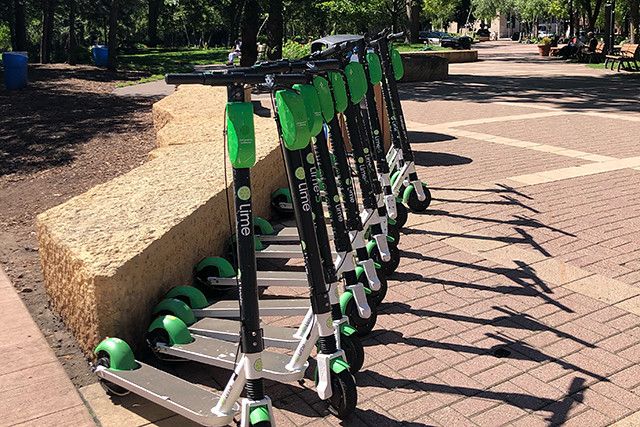Potential Transit Improvement Solutions
There are a number of potential design solutions for Rice Street would prioritize public transportation users.
Share your feedback on transit solutions
Photo examples
The image gallery shows an example of each potential design solution described below.
Mobility hubs
Mobility hubs are pedestrian realms for micromobility modes that offer amenities essential to transit areas including wayfinding, scooter share, bike share and bike parking.
Benefits
- Enhances first-last mile connectivity through shared bike and scooter programs.
- Increases availability of bike parking and secure bike rooms.
- Provides safe and comfortable bicycling supportive facilities.
Challenges
- May produce conflicts with plows and street cleaning vehicles in the winter.
- Coordination of agency or privately owned equipment.
- Maintenance costs.
Project goals addressed
- Safe pedestrian accommodations
- Safe bicycle connections
- Healthy community
- Welcoming streetscape
Shared bus/bike lanes
Shared bus/bike lanes accommodate bicyclists and buses at low speeds and moderate bus headways. Buses are discouraged from passing, and bicyclists pass buses only at stops.
Benefits
- Provides basic bicycle access on transit streets when no space is available for dedicated bikeways.
- Provides increased space and visibility for active street users while improving transit service reliability.
Challenges
- Not a high-comfort bicycle facility.
- Not a substitute for dedicated bikeways, particularly on high-volume bus routes.
- As bus service increases, the number of passing events increases, lessening the comfort and safety for bicyclists.
Project goals addressed
- Safe bicycle connections
- Improved transit service
- Safe traffic operations
Business access and transit lanes
Business access and transit lanes help buses and other vehicles move more efficiently through traffic and provide better access to businesses. These curb lanes, located along the route, are reserved for turning vehicles and buses.
Benefits
- Improves transit service reliability.
- Provides dedicated space for delivery vehicles on busy roadways.
Challenges
- Delivery vehicles can act as barriers for buses on busy routes.
Project goals addressed
- Improved transit service
- Safe traffic operations
- Economic development and business support
Flexible curbside lane
The lane adjacent to the curb can be used as a flexible space for transit vehicles, vehicle parking, micromobility, pickup/delivery vehicles and shared cars. They are often seen where parking is either not provided or not well utilized.
Benefits
- Flexible use allows for various prioritized users depending on time of day.
- Prioritizes space for people arriving at their destination or transferring between different ways of getting around (for example: arriving in a rideshare and transferring to walking on the sidewalk).
- Prioritizes space for commercial goods to reach local businesses without blocking dedicated bus lanes or parking.
Challenges
- Does not prevent delay for transit vehicles due to interactions with parking or loading vehicles.
- Must be enforced if intended use changes throughout the day.
- Eliminates dedicated parking either temporarily or permanently.
Project goals addressed
- Improved transit service
- Economic development and business support
- Public safety
Enhanced transit shelters with dynamic signage
Transit shelters can be enhanced to include benches for riders waiting for the bus, shelter from the weather, heaters for the winter and/or dynamic signage displaying real-time information on the approximate arrival time of transit.
Benefits
- Provides real-time transit information for riders.
- Improves streetscape.
- Improves waiting experience for riders.
Challenges
- Added cost for each bus stop.
- Additional space requirements in the pedestrian right-of-way.
- Maintenance costs.
Project goals addressed
- Improved transit service
- Welcoming streetscape
